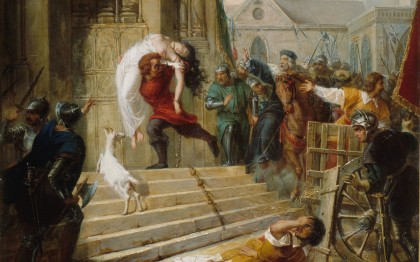The young man who, in 1816, wrote, ‘I want to be Chateaubriand or nothing’, was deeply affected by reading Génie du christianisme (The Genius of Christianity). With this work, published in 1802, the year of Hugo's birth, Chateaubriand triggered a re-evaluation of the Christian heritage in France and followed in Goethe’s footsteps in celebrating Strasbourg Cathedral. ‘The Gothic style,’ wrote Chateaubriand, ‘notwithstanding its barbarous proportions, possesses a beauty peculiar unto itself.’ It had a major influence on Victor Hugo's early career.
In 1825, aged 23, Victor Hugo witnessed the coronation of Charles X in Reims Cathedral. This sight had a sufficiently strong impact on him for the building to resurface in his pen and ink drawings, the majority of which are populated with fantastical Gothic visions.
The publication of The Hunchback of Notre-Dame in 1831 was a major literary event. This work, in which the cathedral itself is the main character, acted as a stimulus for all forms of art. Painting and illustration would provide images for this modern myth, whose heroes were called Esmeralda, Quasimodo and Frollo. The work embodied the aspirations of a generation at a crossroads, and a new awareness of a heritage which fired up people's imaginations.
Victor Hugo constantly strove to preserve mediaeval architecture, particularly during the modernisation work carried out in Paris. Normandy played a key role in shaping his beliefs, as can be seen in a letter he sent to his wife in 1835. ‘I have seen Rouen. Tell Boulanger that I have seen Rouen. He will understand everything that word means [...] I saw it all [...] the Gros-Horloge, Saint Ouen, Saint Maclou, the stained glass windows of Saint Vincent, the fountains, the old sculpted houses and the enormous cathedral which is constantly revealed in all its magnficient glory at the end of the every street. I climbed the cathedral's clock tower and the tower of Saint Ouen. From above, the town and the countryside are admirable.’

